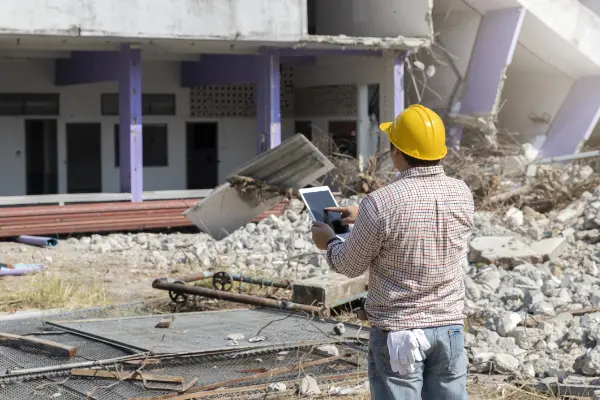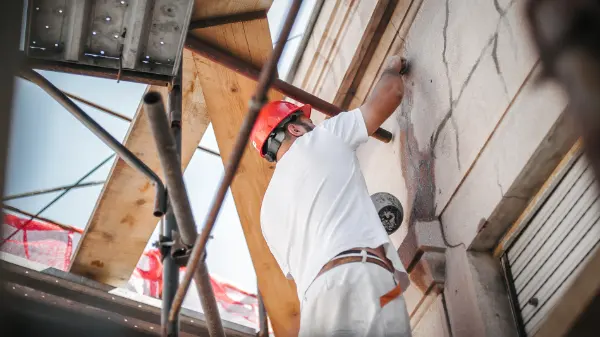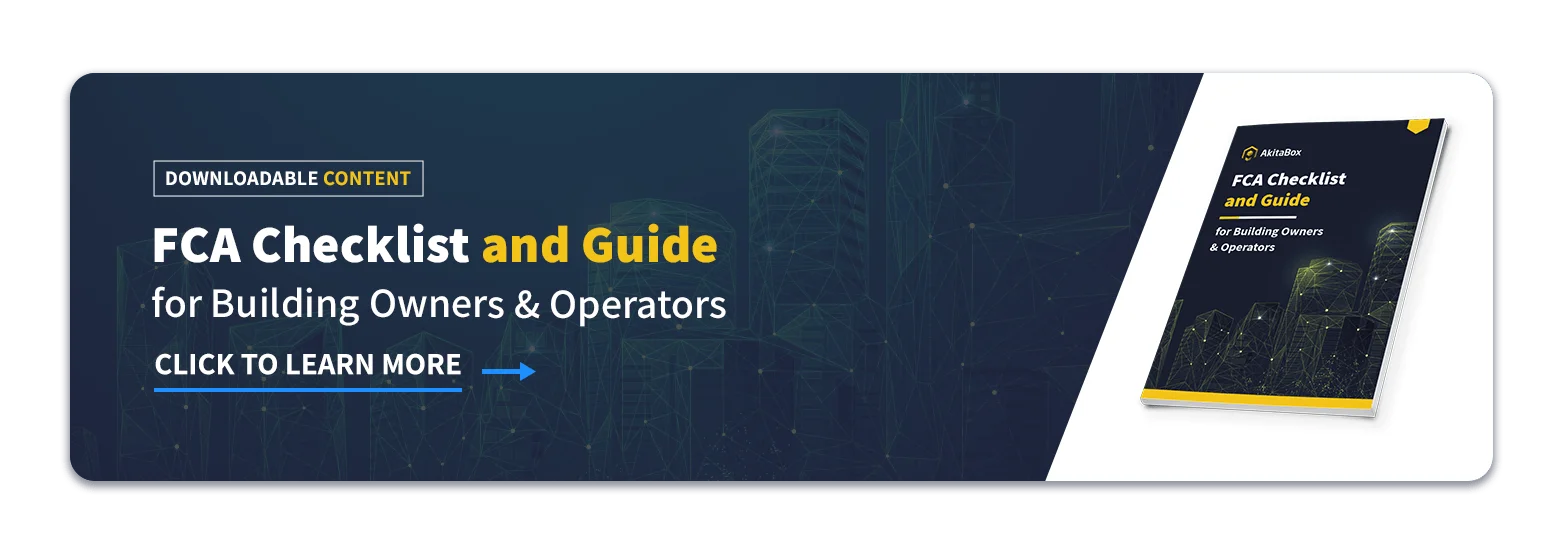The number of natural disasters has increased fivefold over the last 50 years. Whether it’s a storm, fire, flood, tornado, earthquake, or hurricane, your organization is more at risk of being damaged by a climate-related event now than ever before.
Think your particular organization won’t be affected? Well, between January 2013 and January 2023, 88.5% of all U.S. counties declared a natural disaster. And a disaster can cost you big bucks.
Economic losses from storms, floods, fires, etc. have increased sevenfold from the 1970s to the 2010s. From 2010-2019, natural disasters caused $383 million of losses a day on average. In the 70s, losses were only $49 million per day on average.

Scared yet? You should be. Natural disasters can damage your facilities, hurt your employees and clients, stop your productivity in its tracks, and even put you out of business entirely.
Forty percent of businesses do not reopen after a natural disaster. Another 25% of businesses fail within a year after a disaster and an additional 90% fail within two years.
However, there is a bright spot in all this doom and gloom. Organizations who plan ahead for natural disasters can react and begin recovering more quickly.
But as a facilities manager or building owner, how do you plan for something as catastrophic as a fire, flood, or hurricane? Where do you even begin?
That’s where the four phases of disaster management come in. They’re a useful framework to build your disaster recovery and business continuity plans around. An up-to-date facility condition assessment is another important tool for disaster management that, as you’ll read below, plays a key role in all four phases.
The 4 Phases of Disaster Management
Think of disasters as recurring events that take place in four main phases:
1. Mitigation
2. Preparedness
3. Response
4. Recovery
All organizations are in at least one phase at any given time. Understanding these four phases empowers your organization to prepare for and respond to crises in a smarter, more informed way. Making the right decisions gives your organization the best chance at survival and recovery following a climate-related event.
Let’s take a closer look at what the disaster management phases mean and how a facility condition assessment helps you in each one.
Phase 1: Mitigation
Meaning: To prevent future emergencies and take steps to minimize their effects
The mitigation phase occurs before a disaster takes place. Here, an organization will take steps to protect people and property, while also decreasing risks and consequences from a given disaster situation. The organization’s main goal is to reduce vulnerability to disaster impacts (such as property damage, injuries, and loss of life).
Examples of mitigation may can include measures such as:
- Clearing space around buildings to create a defensible space against fires
- Adding levees or improving property drainage to protect from flooding
- Securing furniture to floors and walls to help prevent damage/injuries during earthquakes
- Re-locating structures to less disaster-prone areas
How Does an FCA Help in Disaster Mitigation?
One of the most important mitigation strategies is conducting a facility condition assessment (FCA). An FCA shows you the current condition of all your buildings and spotlights areas that need repair or replacement.
If you know your roof has some trouble spots, you can make repairs so the next big storm doesn’t cause leaks and water damage in your building. If you know the insulation around your water pipes is failing, you can re-insulate them before a blizzard’s freezing temps cause your pipes to burst. If you know some of your hurricane-resistant windows are nearing their end-of-life, you can replace them before next hurricane season.
An FCA also highlights where your highest value or most critical buildings are located. If you know you have a facility in an area with greater risk of weather disasters, you can prioritize that facility in your mitigation efforts.
Phase 2: Preparedness
Meaning: To take actions ahead of time to be ready for an emergency
The preparedness phase also occurs before a disaster takes place. Here, an organization attempts to understand how a disaster might affect overall productivity and the bottom line. The organization will also provide appropriate education while putting preparedness measures into place.
Examples of preparedness include hosting training, education, drills, tabletop exercises, and full-scale exercises on disaster preparedness. This ensures that stakeholders know what to do in the event of an emergency. Updating egress plans also falls under preparedness.
Organizations may also assemble a team to create a business continuity plan and list of resources needed to recover from a disaster.
How Does an FCA Help in Disaster Preparedness?
An FCA stores key information about your assets and building envelope that will come in handy if you need to order replacements. You can easily look up the manufacturer, model or serial number, and other details about a specific asset.
In addition, an FCA contains photos and descriptions of the current condition of every part of your facilities. This is extremely important if you need to make an insurance claim. These “before” photos of what your building looks like pre-disaster can prove to your insurance adjuster that yes, your roof was in pristine condition before a tornado tore it off and yes, you expect insurance to pay for a completely new roof.
For these reasons, it’s important that your FCA is always current. An outdated FCA is an inaccurate FCA and it won’t be as helpful to you. Today’s living FCAs are conducted using specific building assessment software that enables facilities teams to keep them up-to-date over time.
Phase 3: Response
Meaning: To protect people and property in the wake of an emergency, disaster, or crisis
The response phase occurs in the immediate aftermath of a disaster. Organizations must focus their attention on addressing immediate threats to people, property, and business. Occupant safety and wellbeing largely depends on your preparedness levels before disaster strikes.
The most notable example of the response phase is ensuring that people are out of harm’s way. The organization can then move on to assess damage, implement disaster response plans, triage cleanup efforts, and start resource distribution as necessary.

Businesses will also need to navigate building closures, preliminary damage assessments, and hampered communication with stakeholders (like staff, vendors, and suppliers) due to shutdowns.
As the response period progresses, focus will typically shift from immediate emergency issues to conducting repairs, restoring utilities, re-establishing operations, and cleaning up. The organization will also need to begin planning the reconstruction of damaged infrastructure.
How Does an FCA Help in Disaster Response?
Your living FCA is the bible when it comes to what assets make up your facilities. As such, it’s a great tool to use as you assess the damage after a disaster. It helps ensure you don’t miss potentially impacted assets as you move through the facility. It’s also the perfect place to note which assets are partially damaged, not damaged, or a total loss.
Once you’ve assessed the damage, your FCA makes it easy to see the overall damage across your facilities and then prioritize and assign repair work.
In addition, because an FCA includes the estimated costs of repairing or replacing each asset, you can more immediately calculate the financial impact of the disaster.
Phase 4: Recovery
Meaning: To rebuild after a disaster in an effort to return operations back to normal
The recovery phase takes place after a disaster. This phase is the restoration of an organization following any impacts from a disaster. By this time, the organization has achieved at least some degree of physical, environmental, economic and social stability.
The recovery phase of a disaster can last anywhere from six months to a year (or even longer depending on the severity of the incident).
An example of recovery is creating strategic protocols and action plans to address the most serious impacts of a disaster. The protocols should give clear steps to follow for various disaster events and cover multiple scenarios.
For example, a flood protocol could include:
- The organization’s internal plan to mitigate the effects of water (fan deployment, etc.)
- The preferred water remediation service and their contact information
- If that vendor is unavailable, secondary and tertiary services to contact

In this phase, the organization works to obtain new resources, rebuild or create partnerships, and implement effective recovery strategies. The organization also takes steps to reduce financial burdens, rebuild damaged structures, and reduce vulnerability to future disasters.
How Does an FCA Help in Disaster Recovery?
Your living FCA is a place to record all of the damage resulting from the disaster as well as how much it cost to get your facilities operational again.
This information can help you determine how well (or poorly) your assets performed in the disaster and find ways to improve your facilities infrastructure ahead of the next disaster. For example:
- Did the fire retardant building materials do their job?
- Were the windows and doors strong enough to withstand high winds?
- Would it be more cost effective in the long term to install a different type of roof that’s more disaster-proof instead of repairing it after every storm?
Business Continuity Made Easy: Your Free eBook
A disaster management plan is only one part of a successful business continuity plan. Whether your organization is looking to revamp its current business continuity plan or wanting to start fresh with a new one, AkitaBox makes it easy.
Here’s a handy step-by-step guide to business continuity planning. Inside, you’ll find resources including a BCP outline, a business impact questionnaire, and other helpful tools.
Read Next:
- The Importance of a Business Continuity Plan
- Get a Free Guide to Writing a Solid Building Safety and Security Plan
- 10 Steps to Creating an Emergency Response Plan for Your Business
- 5 Risk Mitigation Strategies for Facilities and Construction Teams
- Learn more about the 4 Phases of Disaster Management on the FEMA site


